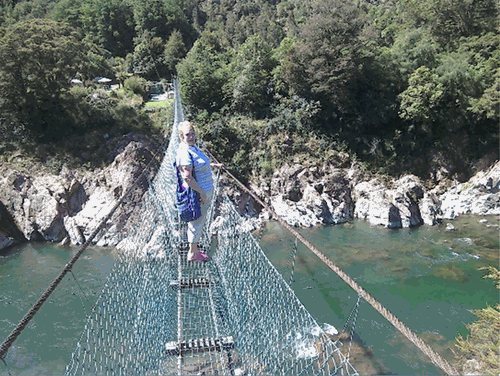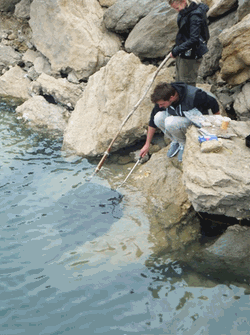



The Parish Church of St George the Martyr, Waterlooville

Rosemary Monk continues the story of her recent holiday in New Zealand and Australia.
Before we left Westport we drove out to the Cape Foulwind, named by Captain Cook after he suffered in a terrible storm there – interestingly, the Maori call it Tauranga which means “Sheltered Anchorage”! We passed a chap on a skateboard, carrying his surfboard down to the beach but there wasn’t much surf and very few seals at the seal colony so we moved on and had coffee in Westport itself. The port is fairly quiet these days but it was once bustling with activities related to the booming coal industry. Now the coal is taken across the island by train to the port at Lyttleton. The town is pleasant and “olde worlde” and the gateway to outdoor activities in the area.
Autumn 2015
Kiwi Travels - onwards and downwards
We headed east up the Buller Gorge surrounded by spectacular scenery, the road hugging the sides through tunnels and overhanging cliffs. There were several kayakers paddling along the river. We had a picnic lunch at Lyell which is the site of an old mining township. Now all that is left is the graveyard. There are signs outlining the rules for Gold Fossicking – panning for gold basically, but fossicking sounds more fun! The old trails out to the mines are now being developed as mountain bike trails so the Old Ghost Road is being revived. At the Buller Gorge Swingbridge we explored the old gold mining site and saw the effects of the 1929 earthquake. The fault line shifted dramatically and you walk along a significant drop. There are also signs showing how high the river can rise at times of great floods. We decided against the return crossing by zip wire when we calculated the cost at more than 2 dollars a second!
Guided by the excellent Tourism Radio gismo we were using for the trip we discovered a relatively new camp site near Murchison. We were directed by the owner to the swimming cove on the river and were pleasantly surprised to find the water warm enough to relax in while the main river swept by. The weather was warming up nicely and the rocks obviously helped warm the water. The next day we drove north east through more spectacular scenery towards the Abel Tasman National Park. The area around Tasman Bay is famed for its hop and fruit growing and we passed acres of apple, pear and Kiwi fruit orchards and miles of hops on frames. The drive up and over Takaka Hill gave us wonderful views across the bay towards Nelson and northward over Golden Bay, our destination for the night. The camp site had us virtually on the beach but the sea was a bit chilly and our electric lead wouldn’t reach the plug – so we moved nearer the loo blocks and a socket as it got dark. Takaka is a wonderfully “hippy” place with wholefood shops, floaty, gypsy style clothes and barefoot, dreadlocked lifestyle. We explored the coast as far north as we could before the tarmac road ran out (you cannot drive hire vehicles on gravel roads) so we couldn’t visit Farewell Spit, the northwest extremity of South Island. Since the local community was busy at the time rescuing a vast number of beached whales, they probably didn’t want tourists hampering the operation. Sadly, it is a fairly frequent problem as the whales seem unable to navigate around the long sand spit.


The following day we headed east again a short distance, to Pohara, as recommended by a friend in Nelson. Once again we were virtually on the beach so enjoyed walks along the sand with just the gulls for company. We explored the coastline and discovered the Abel Tasman memorial – a rather plain monolith considering the part he played in the history of New Zealand. Tea time brought us to Tarakohe harbour and a date with coffee on board the Espresso boat – claiming to be Jacques Cousteau’s old ship. More exciting was the fact that it was feeding time for some huge sting rays which come in to be fed from the end of a stick. We had a good night’s sleep, lulled by the sound of the sea. Then it was time to move on to Nelson via another “hippy” town, Motueka and a lunchtime stop at Mapua Wharf. This reminded us of Emsworth – only better as it had a brewery. It was a lovely sunny Sunday and there were lots of people enjoying the bars and restaurants. For the sake of George’s Men, Colin managed to sample a beer at the Golden Bear micro brewery. Our next stop was Rabbit Island, home of a nice vineyard (and wine) and a forest reserve which is similar to the QE forest but with a beach.
We reached Nelson and found our friend. She is living in a bach (holiday home) while lecturing at Nelson University as her home in Lyttleton was damaged in the first Christchurch earthquake and destroyed in the second. She counts herself lucky as her possessions were in storage by the time the house was lost. Four years on it is just about rebuilt and ready for habitation again. Her account of being in the office in Christchurch when the 2011 earthquake occurred was hair raising. At the time they hadn’t realised that the centre was there on South Island. They quite expected to hear that Wellington had been razed to the ground. We parked on the drive for our overnight stop and enjoyed an evening stroll round Monaco – the area of Nelson popular for sailing. Our favourite road sign was spotted here in a quiet residential street facing the beach. “Warning! Rug Rats and Old Biddies all over the place”.

The following morning we waved Felicity off to work and headed into town to find Eggs Benedict and coffee at Robert Harris – a pleasant chain of coffee shops in NZ with free wifi. Then it was off to discover the Cathedral which is at the top of a long climb of steps (63 in all). Fortunately there is road access up the hill behind for those unable to walk. Christ Church Cathedral is an art deco design, started in 1925 but only finished in 1965 due to arguments about the original design versus more modern trends. It was finally consecrated in 1972 – 47 years after the foundation stone was laid. A stroll back down the hill took us to South Street which is an historic street of original workman’s cottages, now much sought after quaint houses, and then the shop and workshop of Jens Hanson. He was the goldsmith who created the rings used in the Lord of the Rings films. At great expense you too can own a copy. More importantly for some of the family, we discovered the playing field where the first game of Rugby in New Zealand was played. Nelson Town Football team played Nelson College on May 14th 1870. The Town team won 2 – 0. From there we hiked up Botanical Hill to see the spire (trig point) that proclaims it New Zealand’s geographical centre. The views are wonderful – once you have caught your breath!
Rosemary Monk